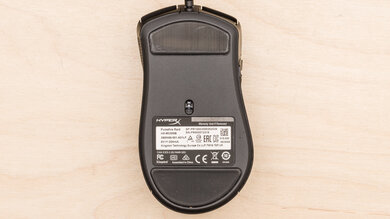The HyperX Pulsefire Raid is a good, versatile gaming mouse. It feels well-built and has a comfortable, right-handed shape with rubberized side grips, five side buttons on the left, and two independent RGB lighting zones. It's suitable for all grip types, but small hands may have difficulty reaching the front side buttons using any grip type, and extra-large hands will likely drape over the mouse using a palm grip. Performance-wise, it has a wide CPI range, a CPI you can adjust by increments of 50, and a very low lift-off distance. Unfortunately, the sensor is slightly inconsistent and tends to undershoot during fast cursor movements more than during slow ones. Also, it has a very high click latency for a gaming mouse, and the customization software is only compatible with Windows.
Our Verdict
The HyperX Pulsefire Raid gaming mouse is decent for office and multimedia work. It feels well-built and has a comfortable right-handed shape suitable for all grip types. Also, it has an impressive number of buttons you can program using the companion software, and its scroll wheel has L/R tilt buttons, but it doesn't unlock for free scrolling. Unfortunately, it also lacks any wireless capability, and the companion software isn't compatible with macOS.
-
Feels well-built.
-
Comfortable shape with rubberized side grips.
-
Scroll wheel has L/R tilt buttons.
-
Wired-only.
-
Scroll wheel lacks a free scrolling mode.
-
Customization software isn't compatible with macOS.
The HyperX Pulsefire Raid is good for FPS gaming. It feels well built and has a right-handed shape suitable for all grip types. It has a wide CPI range, a CPI you can adjust by increments of 50, and a very low lift-off distance. Unfortunately, it's heavy, its cable isn't very flexible, and its click latency is very high for a gaming mouse. Also, its sensor is inconsistent and tends to overshoot the set CPI more during faster mouse movements.
-
Feels well-built.
-
Comfortable shape with rubberized side grips.
-
Scroll wheel has L/R tilt buttons.
-
All eleven buttons are programmable.
-
Heavy.
-
High click latency.
-
Braided cable isn't very flexible.
The HyperX Pulsefire Raid is a good MMO gaming mouse, though some dedicated MMO mice have more side buttons. That said, it feels well-built and has a right-handed shape suitable for all grip types. Performance-wise, it has a wide CPI range, a CPI you can adjust by increments of 50, and a very low lift-off distance. It also has customization software for programming buttons, adjusting lighting, and changing sensor settings. Unfortunately, it has very high click latency for a gaming mouse, and the sensor undershoots the set CPI more during quick cursor movements.
-
Feels well-built.
-
Comfortable shape with rubberized side grips.
-
Scroll wheel has L/R tilt buttons.
-
All eleven buttons are programmable.
-
High click latency.
-
Braided cable isn't very flexible.
The HyperX Pulsefire Raid scores decently as a mouse for ultra-light gaming, but it's significantly heavier than what we'd consider an ultra-light gaming mouse. Also, its braided cable isn't very flexible, and the click latency is very high for a gaming mouse. Nevertheless, it feels well-made and has a right-handed shape suitable for all grip types.
-
Feels well-built.
-
Comfortable shape with rubberized side grips.
-
Heavy.
-
High click latency.
-
Braided cable isn't very flexible.
The HyperX Pulsefire Raid is inadequate for travel use as it's bulky and likely won't fit in most laptop cases. It also lacks wireless capabilities, making it cumbersome to use in small spaces like buses, trains, or planes. That said, it feels well-built, and it has onboard memory so that you can use custom settings on computers without the companion software installed. However, there's only space in memory for a single profile.
-
Feels well-built.
-
Wired-only.
-
Bulky; may not fit in most laptop cases.
- 7.2 Office/Multimedia
- 7.5 Video Games (FPS)
- 7.7 Video Games (MMO)
- 7.3 Ultra-Light Gaming
- 5.0 Travel
Changelog
- Updated Jul 13, 2021: Review published.
- Updated Jun 29, 2021: Early access published.
- Updated May 20, 2021: Our testers have started testing this product.
- Updated May 18, 2021: The product has arrived in our lab, and our testers will start evaluating it soon.
- Updated Apr 20, 2021: We've purchased the product and are waiting for it to arrive in our lab.
Check Price
Differences Between Sizes And Variants
The HyperX Pulsefire Raid gaming mouse we tested is black, and there aren't any other color variants. You can see the label for our unit here.
Compared To Other Mice
The HyperX Pulsefire Raid is a versatile gaming mouse aimed at battle royale, MOBA, and MMO players. Its main selling point is its eleven programmable buttons, which include five side buttons. It also has a scroll wheel with L/R tilt buttons, rarely seen on gaming mice. Unfortunately, while it has solid sensor performance overall, its sensor is inconsistent. Also, it has very high click latency, and gamers playing fast-paced or competitive games may prefer something more responsive-feeling.
Check out our recommendations for the best wired mice, the best gaming mice, and the best mice for MMOs.
The Razer Viper Mini is an excellent FPS gaming mouse, while the HyperX Pulsefire Raid is a good, versatile gaming mouse. The Razer is substantially lighter and feels sturdier. It has a more flexible cable, mouse feet that glide more smoothly, and much lower click latency. Comparatively, the HyperX has three additional side buttons, a wider CPI range, a more precisely adjustable CPI, and a lower lift-off distance. Unfortunately, both mice have inconsistent sensors that undershoot their CPI during fast mouse movements. The Razer is better suited for smaller hands, while the HyperX isn't suitable for small hands using any grip type.
The HyperX Pulsefire Raid is a more versatile wired gaming mouse, while the HyperX Pulsefire Haste has better overall performance. The Haste is much lighter and feels sturdier. It has a more flexible cable, mouse feet that glide more smoothly, and much lower click latency. It also has an ambidextrous shape and is nearly universally suitable for all grip types and hand sizes. On the other hand, the Raid has a more precisely adjustable CPI and a right-handed shape best-suited for larger hands using a claw or fingertip grip or medium and large-sized hands using a palm grip.
The Razer DeathAdder V2 is an excellent FPS gaming mouse, while the HyperX Pulsefire Raid is a good, versatile gaming mouse. The Razer is lighter and has mouse feet that glide more smoothly. It also has a wider CPI range and a lower click latency. It has fewer programmable buttons and only two side buttons, but you can bind a HyperShift button to enable a second layer of commands. Comparatively, the HyperX has three additional side buttons and a mouse wheel with L/R tilt buttons. Both mice are suitable for all grip types, but neither is well-suited for small hands.
The Logitech G502 HERO is a better, more versatile gaming mouse than the HyperX Pulsefire Raid. The Logitech feels sturdier and comes with a set of adjustable weights. It also has a wider CPI, a more consistent sensor, a lower click latency, and a scroll wheel that unlocks for free scrolling. Additionally, it has customization software for Windows and macOS. Comparatively, the HyperX is lighter and has two additional side buttons. Both mice are suitable for all grip types, but neither is suitable for small hands.
The Logitech G403 HERO is an excellent FPS gaming mouse, while the HyperX Pulsefire Raid is a good, versatile gaming mouse. The Logitech is somewhat lighter and feels sturdier. It also has a more flexible cable, a wider CPI range, a more consistent sensor, and a lower click latency. Additionally, it has companion software compatible with Windows and macOS. Comparatively, the HyperX has three additional side buttons and a scroll wheel with L/R tilt buttons. Unfortunately, its companion software is only compatible with macOS. Both mice are suitable for all grip types but primarily for medium and larger-sized hands.
The HyperX Pulsefire Raid and the MSI CLUTCH GM30 are wired gaming mice with comparable performance. The HyperX has a higher maximum CPI, a more precisely adjustable CPI, and a lower lift-off distance. It also has five additional programmable buttons. On the other hand, the MSI has lower click latency. The HyperX is a right-handed mouse, while the MSI is an ambidextrous mouse. Both mice are well-suited to all grip types and most hand sizes.
Test Results
The polling rate options on the HyperX Pulsefire Raid are 125Hz, 250Hz, 500Hz, and 1000Hz. Unfortunately, the sensor is inconsistent and undershoots the set CPI more during fast cursor movements.
For a mouse with lower latency, check out the Gigabyte AORUS M5.
While two of the five side buttons on the HyperX Pulsefire Raid work by default to navigate forwards and backward while browsing the web, you can't reprogram these buttons or program the other three side buttons on macOS because of the lack of compatible software.
Comments
HyperX Pulsefire Raid: Main Discussion
Let us know why you want us to review the product here, or encourage others to vote for this product.































